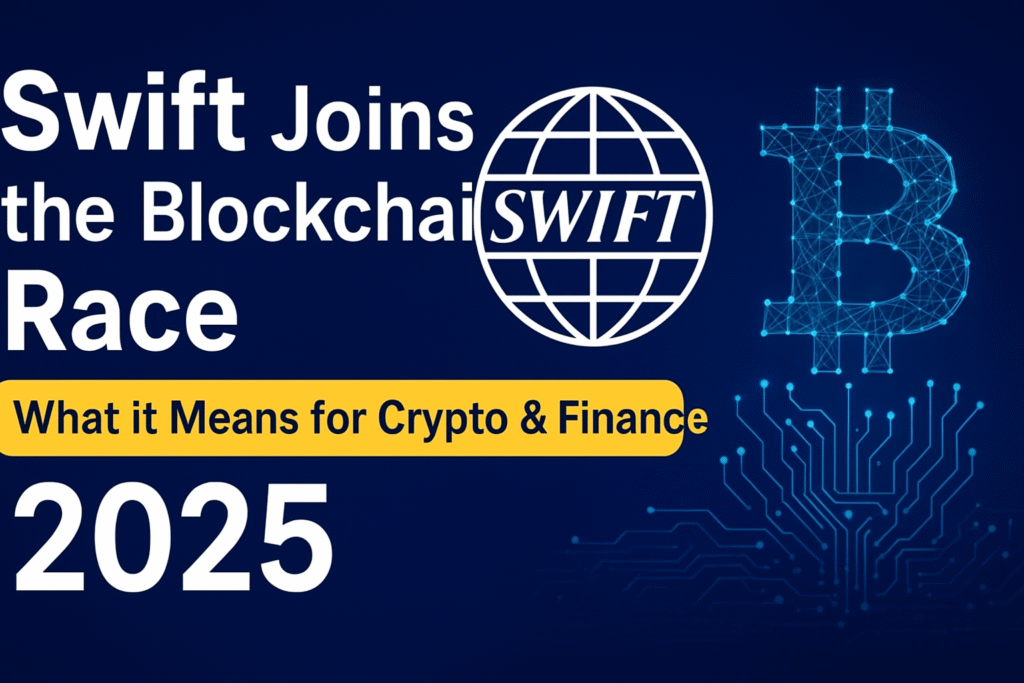Introduction
Big news is making waves: SWIFT, the global interbank messaging and payments network used by thousands of financial institutions, is planning to launch its own blockchain system to compete with (and complement) stablecoins and digital payments networks. Financial Times
This move highlights a broader shift: traditional finance (TradFi) is no longer ignoring crypto & blockchain — it’s embracing it. In this post, we’ll unpack what SWIFT’s blockchain plans could mean for trading, crypto, and the future of money.
What Is SWIFT Building?
- SWIFT wants to modernize cross-border payments by enabling tokenized product payments, including via stablecoins. Financial Times
- It’s reportedly teaming up with big banks (e.g. Bank of America, Citigroup, NatWest) and blockchain firms like ConsenSys. Financial Times
- The ambition: instantaneous, always-on payments using blockchain’s transparency and settlement features. Financial Times
Why This Matters
1. Legacy Finance Meets Crypto
TradFi players are realizing they can’t ignore blockchain if it offers speed, lower cost, and global reach. SWIFT entering this space is a strong signal that institutional adoption is deepening.
2. Stablecoins & Tokenization Get a Boost
SWIFT’s new blockchain will likely integrate or support stablecoins. Tokenized assets and on-chain financial instruments become more legitimate and accessible.
3. Interoperability & Competition
As SWIFT builds its blockchain, interoperability with existing blockchains (Ethereum, Solana, etc.) will be a focal point. This could push more cross-chain innovation.
4. Strategic Timing
This comes as stablecoin regulation is tightening around the world (e.g. the U.S. passed the GENIUS Act regulating stablecoins) Wikipedia.
Also, China launched an offshore yuan-linked stablecoin (AxCNH) in Kazakhstan, signaling that countries are using blockchain for diplomatic & financial reach. Reuters
Implications for Crypto Traders & Developers
If you’re active in crypto or building blockchain systems, here’s what to watch and act on:
| Area | What Could Change | Action You Can Take |
|---|---|---|
| Payments & Stablecoins | More stablecoins will be used in mainstream commerce | Monitor tokenization projects and stablecoin regulatory moves |
| Bridges & Interoperability | SWIFT’s blockchain must talk to other chains | Learn cross-chain standards (e.g. IBC, CCIP) |
| Volatility / Market Moves | When TradFi joins crypto, flows could amplify trends | Stay alert for news that triggers large capital shifts |
| New Use Cases | Tokenized assets, on-chain settlements in trade finance | Explore DeFi protocols combining real world assets + payments |
Challenges & Risks
- Regulation & Compliance: SWIFT must navigate global financial laws, AML/KYC, and stablecoin oversight.
- Adoption Curve: Banks will adopt gradually — integration, legacy systems, and trust will slow certain flows.
- Security & Audits: Any blockchain for global payments will be under pressure to prove safety and immutability.
- Interoperability Complexity: Bridging existing blockchains, legal contracts, and legacy systems is nontrivial.
What to Do Next
- Watch the rollout: Pay attention to press releases from SWIFT, partner banks, blockchain firms.
- Learn tokenization & on-chain settlement: Projects using real-world assets will benefit.
- Prepare for hybrid systems: Expect ecosystems where traditional finance and crypto converge.
- Follow regulation closely: In many countries, law will shape how quickly these systems can function.
Conclusion
With SWIFT entering blockchain, we may be witnessing a turning point — where crypto isn’t just a parallel system, but becomes integrated into global finance. For traders, builders, investors — opportunity and disruption lie side by side.
At Kaundal VIP, we’ll be tracking how SWIFT’s blockchain evolves, how markets react, and how you can position yourself in this new wave.



